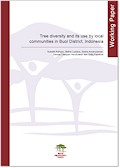| Working Paper Series |
 |
|
| Title | Tree diversity and its use in Buol District, Indonesia | | Author | Subekti Rahayu, Betha Lusiana, Sacha Amaruzaman, Dienda C.P. Hendrawan and Sidiq Pambudi | | Year | 2015 | | Publisher | World Agroforestry Centre (ICRAF) Southeast Asia Regional Program | | City of Publication | Bogor, Indonesia | | Series Number | Working Paper 212 | | Number of Pages | 36 | | Call Number | WP0195-16 | | Keywords | Agroforestry, Buol, Central Sulawesi, community forest use, tree diversity, tree species’ richness |
|
| Abstract: |
| We assessed plot-level, tree diversity and various tree-based systems in Buol District, Central
Sulawesi Province, Indonesia: complex, clove, coconut and cacao agroforests; monoculture teak; and
undisturbed and disturbed forests. The objectives were to assess the tree diversity of various land-use
systems, to identify what tree species were used by the communities and to identify land-use systems
that provided habitats for forest tree species. The indicators for tree diversity were tree species’
richness and tree composition collected using a Quick Biodiversity Survey approach. The use of tree
diversity by the communities was assessed though focus-group discussions in three clusters of
villages: the upstream and midstream of the Buol watershed; and the coastal area. We found that tree
species’ richness in complex agroforests was 70% that of undisturbed forests. Only 5% of forest
species regenerated in complex agroforestry systems, mostly represented by pioneer species. This
condition indicated that although the complex agroforests species’ richness in Buol was relatively
high, complex agroforests could not provide refugee for forest tree species. Therefore, conserving
forests was very important for maintaining forest tree diversity in Buol. The remaining small patch of
disturbed forest in Buol District was in a developing stage, indicated by higher species’ richness at
sapling stage. The community in Buol had low dependency on forest species and were more interested
in growing domesticated, commercial species. Not so long ago, farmers still harvested rattan from the
forest but at the time of study the rattan population had diminished, most likely caused by overharvesting. |
|
|
Download file(s): Click icon to download/open file.
|
| |
File Size |
Description |

|
1,680 KB |
Softcopy |
|
|
|
| Viewed in 327 times. Downloaded in 468 times. |